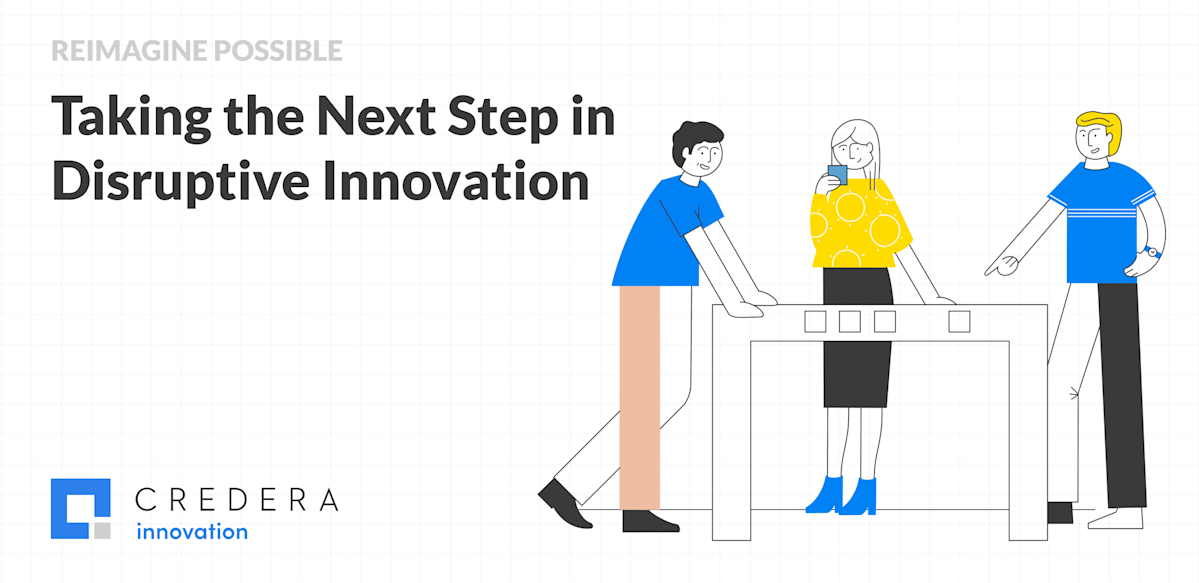Transformation
May 19, 2021
Disruptive Innovation: Sprints Designed to Capture Market Share

Marketplace disruption is constantly happening. Emerging startups with a high tolerance for risk and cash from venture capitalists quickly develop new products or services that change consumer perspectives.
15 years ago, the thought of getting in an unknown person’s car for a trip to the airport would have been unheard of. Uber disrupted the transportation industry.
But disruption can also occur from existing companies who have an innovative culture and willingness to invest in disruption.
20 years ago, the thought of receiving a package in less than two days was a pipe dream. Amazon disrupted the shipping industry.
Whether disruption comes from an emerging startup or a stable company in the industry, businesses will change over the next decade (and then long after that as well). Companies who can see disruption on the horizon—or, even better, be the ones who bring disruption to the forefront—will be the dominant market players in the next decade of innovation and market expansion.
To help our clients be on the forefront of disruption, we run disruption sprints to uncover gaps in their portfolio. The process highlights where competition has taken market share or consumer preferences have evolved or changed over time.
The Approach of a Disruption Sprint: Landscape Analysis
To see disruption on the horizon and quickly develop a response, we approach disruption sprints through three main lenses. We look out in the market to spot changing consumer preferences, across the competitive landscape to identify emerging competitors, and into the business itself to understand its technical and operational maturity.
Out: Consumer Research
Today’s consumer is changing. We were changing before the pandemic and will continue to change as we emerge from it.
76% of consumers report it is easier than ever to take their business elsewhere.
Since the beginning of the pandemic, 75% of U.S. consumers tried a new shopping behavior, and many will adopt this new behavior moving forward.
Consumers drive disruption because their preferences, buying habits, and the context of their lives change on a regular basis. Companies must be constantly aware of not only their existing customer’s preferences, but also their desired customer’s preferences.
We have seen this played out across many of our clients at Credera, and during a disruption sprint we seek to answer three key questions:
What are consumers spending their time/money on?
What are consumer pain points?
How do consumers view our brand?
As companies uncover pain points and compare those to where consumers are spending their time/money, they begin to see some overlap. This overlap will allow companies to see how their market offerings address these needs. Consumers will have evolving pain points and needs as the context of their world continues to change rapidly. Companies must take the time to understand how their offerings address these changing needs before another competitor disrupts their business.
Across: Competitor Analysis
Competition drives growth and innovation in our economy. Historically, companies needed to invest resources to develop products and services that their customer would choose to spend their money on over their competitor. This is still true, however some companies are competing for consumer attention beyond just the next dollar.
Netflix, for example, stated in their 2018 annual report, “We compete with (and lose to) Fortnite more than HBO… Our focus is not on Disney+, Amazon or others, but on how we can improve the experience for our members.”
As we work through our landscape analysis in a disruption sprint, clients go beyond immediate competitors and utilize our lessons in consumer research to address emerging competitors in tangential or new spaces that may not be considered. To do so, we ask ourselves three key questions:
Who are the main players in the market investing in?
What emerging startups are gaining share?
What consumer trends have gained traction?
By understanding who your competition is and what their impact on customers will be, companies are able to understand which products and services they should invest their resources toward to not just avoid losing market share but win more of it.
In: Capabilities Audit
To ensure companies can initiate, launch, and scale innovative ideas we not only focus on external factors, but also the internal capabilities of each company. Innovation, especially the disruptive kind, is quite the puzzle when it comes to comparing the goal of leadership and the internal capabilities of their company.
Deloitte surveyed chief information officers and found that 59% want “excellent or leading future-state innovation” and the reality is, only 11% would say they are currently meeting that vision.
We don’t believe companies have to wait to be excellent in their ability to innovate before they need to invest in innovation. A robust capabilities audit will make sure the created ideas are tangible and real based on the current and short-term future state of the company. To do so, we ask ourselves three key questions:
What is the current operational and technical maturity of the company?
What new technology or processes have emerged in the market?
What investments are currently made?
The capabilities audit shows companies what they can do right now to be disruptive, but also provides a roadmap for how to become more mature in certain business functions to expand their disruptive capabilities.
The Disruption Sprint
The end goal of our two-and-a-half-week landscape analysis work is to sit alongside our clients in a three-day workshop to design the disruptive idea that will be desirable to your consumers, feasible to implement, and viable to your business strategy.
On the first day we take time to understand the landscape and see what common themes are identified across the consumer, competitor, and capability lenses. As we look at those themes, we try to map where exactly on the customer journey disruption will occur.
We start the second day with disruptive brainstorming sessions that address the identified disruption points in the previous day’s exercise. As we cluster and develop ideas, we are thinking through some key questions:
Can our organization deliver on this idea?
Will this idea provide a positive ROI?
Would our consumers even like this idea?
On the third day, we prioritize our ideas based on how they score against these questions and end the workshop with a very clear roll-out strategy to develop a proof of concept (POC) to test our hypothesis in the market.
Taking the Next Step in Disruptive Innovation
Our structured approach to disruption identifies potential threats and turns them into opportunities for growth. Disruption happens in each market, and we will partner with you to be proactive in your response to it.
If you would like to learn more about our disruption sprints or innovation strategy, reach out to us at marketing@credera.com.
Contact Us
Let's talk!
We're ready to help turn your biggest challenges into your biggest advantages.
Searching for a new career?
View job openings


